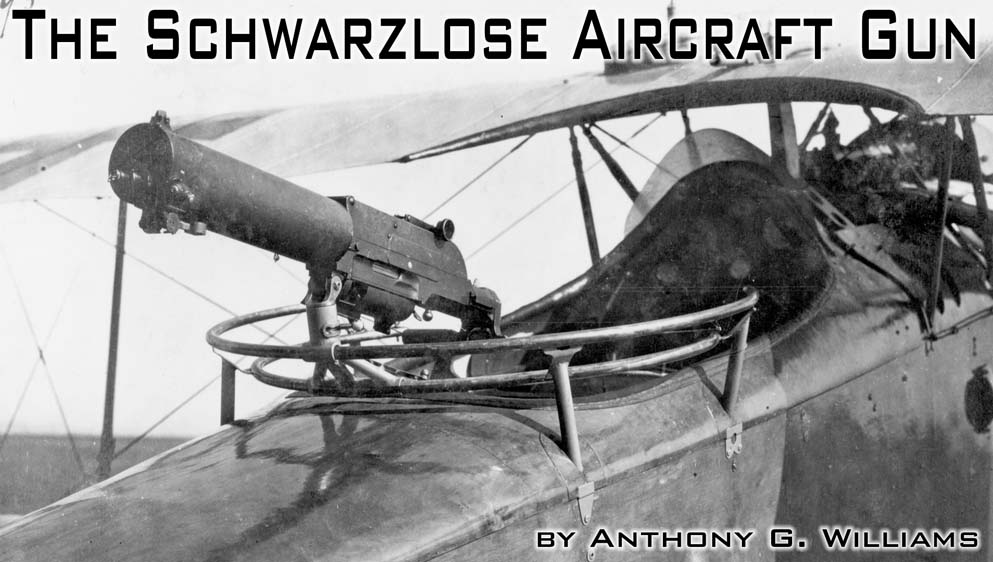Schwarzlose M07/12 on an Aviatik Berg C.I in 1917. Note the retention of the water jacket and the tubular mount. (Harry Woodman)
By Anthony G. Williams
The Great War of 1914-1918 saw the first substantial use of aircraft in a major conflict. At the beginning the aircraft were almost all frail, underpowered devices that could barely lift themselves and their one or two crew into the air, and carried no armament except for the crew’s personal weapons. By the end of the conflict, heavy bombers carrying multiple defensive machine guns contested the air with fast and agile fighters, typically armed with two fixed machine guns synchronised to fire through the propeller blades. As well as ball rounds these guns fired a variety of specially developed ammunition, loaded with armour-piercing, incendiary and even explosive bullets.
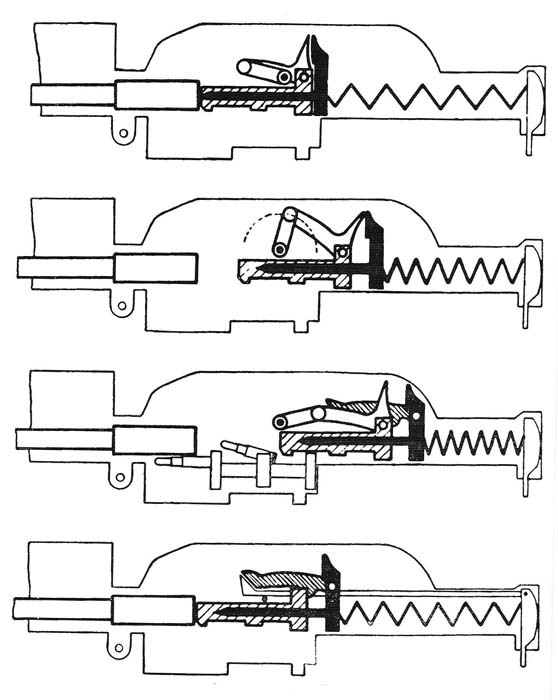
Although machine guns specially designed for the needs of air fighting were being developed at the end of the war, none of these had time to get into service. So with the exception of a few large-calibre cannon, the air war was fought with more or less modified versions of the guns used on the ground by the army.
The Austro-Hungarian Empire, with its capital in Vienna, was one of the major combatants in the Great War, fighting alongside Germany and the Ottoman Empire against France, the United Kingdom, Russia (until 1917), Italy (from 1915, initially only against the Austro-Hungarian Empire), and the USA (from 1917). Defeat in the war led to the break-up of both the Austro-Hungarian and Ottoman Empires.
The standard machine gun of the Austro-Hungarian armed forces was the Schwarzlose. This was designed by a German, Andreas Wilhelm Schwarzlose, who took out the first patent in 1902. It was adopted by the Empire in 1905 as the M05 (Model 1905) and manufactured at the Osterreichische Waffenfabrik Gessellschaft in Steyr, Austria. An improved model, the M07, replaced the M05 two years later, to be replaced in production by the further-modified M07/12 five years after that. However, the older versions remained in service.
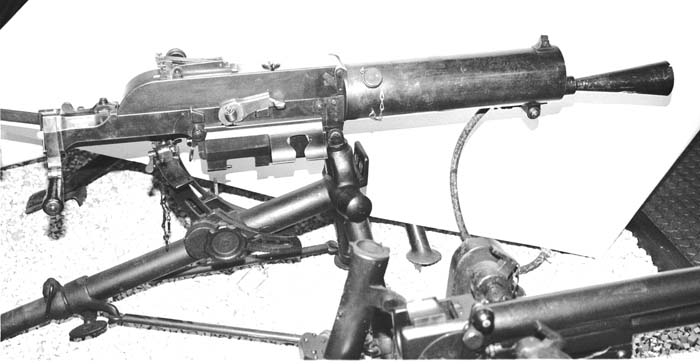
The Schwarzlose was unusual by comparison with the common locked breech short-recoil (e.g. Maxim) and gas-operated (e.g. Hotchkiss and Lewis) guns in that its mechanism used a form of blowback, in which the gas pressure in the barrel forces the cartridge case backwards, pushing the unlocked bolt to the rear of the gun. In its simplest form, the blowback mechanism is restricted to very low-powered cartridges because it is necessary for the inertia of the bolt to hold the case in the chamber until the projectile has left the barrel, otherwise high-velocity burning gas will burst from the breech to the discomfiture of the firer. With high-pressure military rifle cartridges, the weight of bolt required would be so heavy that the rate of fire would be very low.
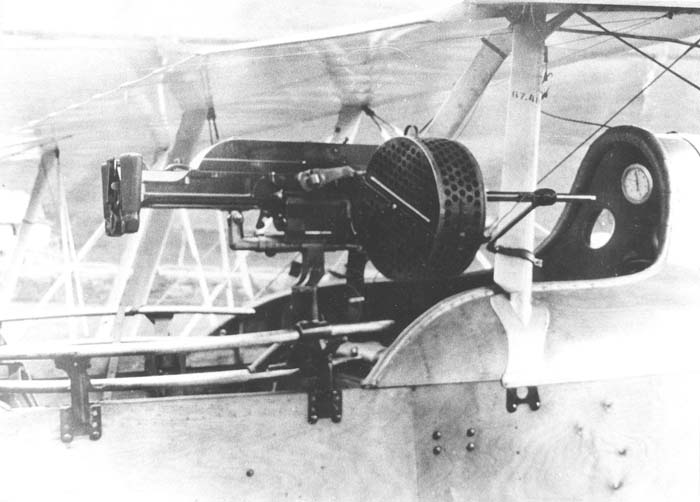
Various solutions to this difficulty have been tried, because blowback weapons are attractively simple and cheap to manufacture. One is the retarded blowback, in which an additional mechanism resists the initial rearward movement of the bolt, and this was the approach adopted by Schwarzlose. His design utilises an elbow joint attached to the bolt by one arm with the other arm pivoted to a fixed axis on the receiver. The effect of this mechanism is to force the initial rearward movement to operate under severe mechanical disadvantage, delaying the opening of the breech until the bullet has left the barrel. Even so, the cartridges it used were so powerful that the breech still opened too quickly. The solution was to shorten the barrel to 20 inches (compared with 28 inches for the Maxim) so that the bullet left the muzzle sooner before the breech could open. It was belt-fed, using a fabric belt. The simplicity of the mechanism kept the cost down to about half that of a Maxim, and the gun was subsequently adopted by several other European countries in a variety of different calibres. The ruggedness and reliability of the Schwarzlose made it a popular gun and it had a long life, though the main problem being the sensitivity of the mechanism to ammunition quality. The Dutch were still making it in 1940, and it was being used at least until 1945 as a second-line weapon in Italy and Hungary.
In army and naval use, the gun is recognisable by the short and wide water-filled barrel jacket, the large conical flash-hider attached to the muzzle (the short barrel presumably resulting in a much bigger muzzle flash than usual) and the curved shape of the back of the receiver. As with all blowback guns there is no primary extraction, so the gun was fitted with an oil tank and the chamber was sprayed with oil before each round was chambered in order to facilitate case extraction. This mechanism was the source of some discomfort in aircraft use when Schwarzloses were mounted in front of the pilot, as he received a constant spray of oil in his face whenever the guns were fired. In at least one installation – in the Albatross fighter – a metal shield and drainage tube were fitted to catch and dispose the oil.
The cartridge in use in the Austro-Hungarian Empire was the 8x50R Mannlicher, developed in 1886 by the Georg Roth ammunition factory of Vienna together with the Vienna Armory, and one of the first of the small-calibre military rounds designed to use the new smokeless powder. The US equivalent was the .30-40 Krag of 1892. The initial loading featured a heavy (244-grain) round-nosed bullet fired at 2,030 fps, although some later specialised loadings, such as the M.08 armour-piercing and the M.17 and M.18 incendiary types, used pointed bullets. There was also an explosive bullet with a blunt nose and a waisted body. These explosive and incendiary types were intended for use against hydrogen-filled observation balloons, initially from ground-fired guns and later from aircraft.
The Schwarzlose as an Aircraft Gun
The Schwarzlose was not an obvious choice for an aircraft gun, being bulky, heavy (at around 43 pounds) and initially slow-firing at around 400 rpm (500 rpm for the M07/12). However, except for a few imported Madsens, Bergmanns and LMG 08/15s, it was all the Austro-Hungarians had available so it was adapted for the task. At the start of the conflict the Empire also pressed into aerial service some Schwarzlose M12s intended for export to Greece, chambered for their 6.5×54 Mannlicher-Schönauer cartridge. This fired a 160-grain round-nosed bullet at 2,230 fps. The M12 guns were lighter, being air-cooled, and were used as flexibly-mounted defensive weapons, but the small bullet was less effective so these were eventually replaced by 8mm guns.

The first change to the gun for aircraft use was the removal of the flash hider. The next concerned the water jacket. Cooling water was not necessary for an aircraft gun: the combination of short bursts of fire and a strong wind keeping the barrel cool enough. So the jacket was frequently emptied of water and fitted with large slots to allow air to circulate. Unlike the Vickers/Maxim short-recoil guns in which the front of the barrel jacket was needed to support the moving barrel, the only other function of the jacket in the fixed-barrel Schwarzlose was to hold the foresight. Once separate sights were used, the jacket could be dispensed with entirely, leaving the plain, skinny barrel protruding rather oddly from the bulky receiver. Despite these modifications, some Schwarzloses fitted to aircraft retained their cooling water jackets to the end of the war.
The M07/12 was found to be sensitive to changes in atmospheric pressure, firing more slowly and finally stopping when the aircraft climbed above an altitude of 10,000 feet. A set of modifications designed by Ludwing Kral raised the rate of fire to nearly 600 rpm and the critical altitude to almost 18,000 feet. Mid-way through the war, a version specifically for aircraft use was developed, the M16, in which the weight was reduced to 29 pounds. Continued development eventually saw the free rate of fire of the M16A increased to 880 rpm, and raised its operating altitude to 23,000 feet. But even in March 1918 fewer than 300 M16s were in service, and the M07/12 remained numerically the most important gun in the inventory.
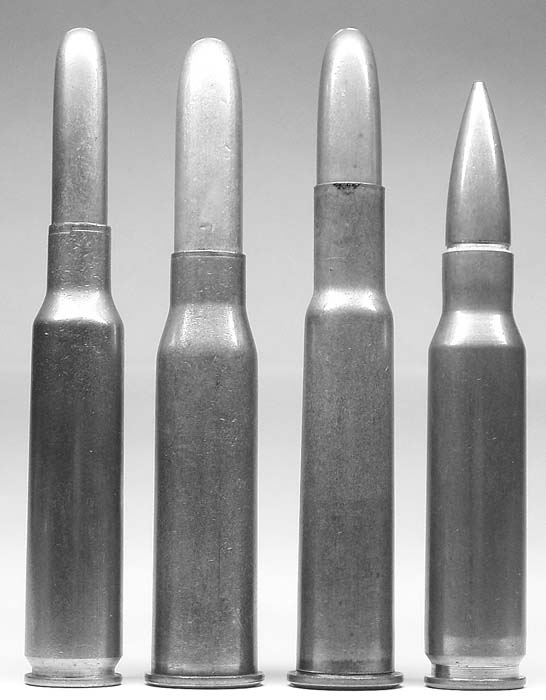
By the middle of the war, it had become established that the most satisfactory layout for a fighter plane was the tractor type, with the engine in front of the pilot. This meant that if the guns were to be kept within reach of the pilot (important at that time, as guns often jammed and needed clearing), their firing needed to be synchronised with the engine revolutions so that the bullets passed between the propeller blades.
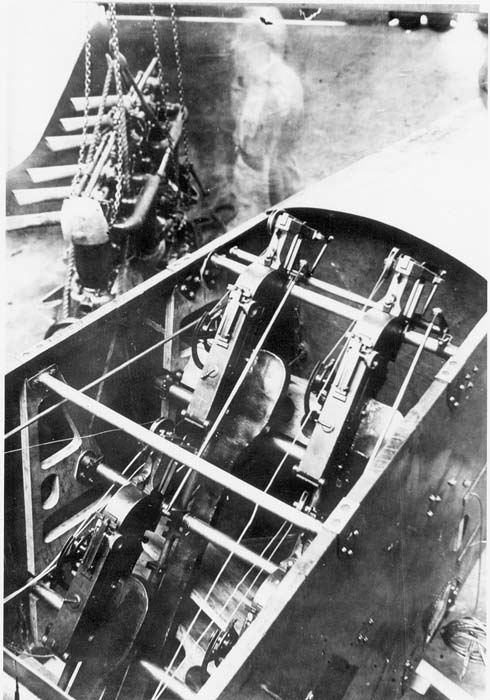
Most synchronisation systems needed to be tailored to the gun they were used with, and the Schwarzlose’s unique mechanism required a purpose-designed system. The most common seems to have been the Zaparka gear, which fired the gun on every fourth propeller revolution. The mechanism could be relied on only within a band of engine revolutions between 1,000 and 1,600 rpm with the M07/12, and 600 to 1,600 rpm with the M16. This explains the very prominent place given in the cockpit of fighters to a large engine tachometer. The 1,600 revolutions per minute limit restricted the maximum rate of fire to 400 rpm regardless of the free rate, and it would obviously have been less at lower engine revolutions. The Bernatzik and Daimler gear reduced the rate of fire even more, by 55% in the case of the M16. However, the Daimler gear did have the advantage that the M16 could be safely fired from engine idle to 1,600 revolutions per minute, although the M07/12 was still restricted to the 1,100 to 1,600 rpm band. None of these systems proved to be entirely reliable, leading to a loss of confidence in the pilots who risked shooting off their own propellers. At the end of the war the Austro-Hungarian forces decided to standardize on the Priesel system.
Aircraft installations
Aircraft used by the Austro-Hungarian Empire were a mixture of indigenous and German types. Some of the latter were specifically made for the Empire, and these were usually armed with Schwarzlose guns.
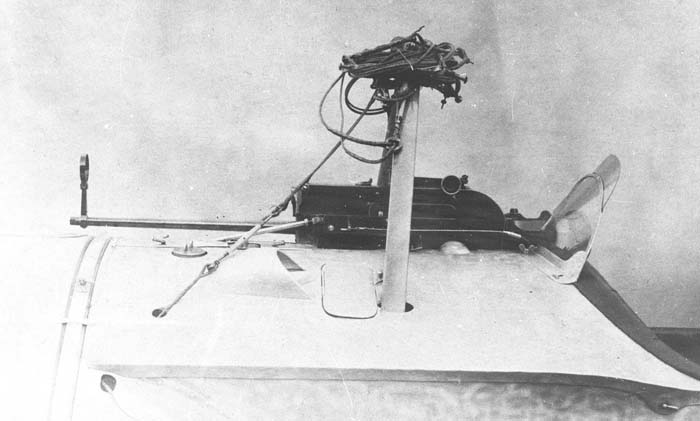
Synchronisation systems for the Schwarzlose were not available until 1916, so earlier fighters needed to find other ways to mount their guns. Among the first of the Empire’s fighters was the German-built Hansa-Brandenburg D.I, armed with an unsynchronised Schwarzlose in a fairing on top of the upper wing so it could fire over the propeller. This fairing was known as the VK canister. The standard version was the Type II VK, which held a gun and 250 rounds of ammunition, plus a gravity fuel tank, but sometimes two guns were installed in the canister. The Hansa-Brandenburg D.I was also built under licence by the Austro-Hungarian Phönix company, but this version did not prove very successful. The Phönix D.I combined its fuselage with new wings, a more powerful engine, and two synchronised Schwarzlose guns. It was a much better fighter, but deliveries started only in the spring of 1918. Very small numbers were delivered of the improved D.II and D.III. After the war, the D.III went on to serve with the Swedish Air Force. The other successful family of Austro-Hungarian fighters was entirely indigenous. The Österreich-Ungarische Aviatik Flugzeugfabrik (not to be confused with the German Automobil und Aviatik A.G., which also built a number of fighters) produced the Aviatik D.I, which in prototype form had a single synchronised Schwarzlose but entered service in the summer of 1917 with two.
In addition to these, the German Albatros D.II and D.III fighters were built in the Empire and armed with two synchronised Schwarzloses. Some Fokker D and E series were also used.
Despite its bulk, the Schwarzlose was also used as a defensive gun in flexible mountings. Single-engined two-seaters (known as the C class in both Germany and the Empire) which carried such armament included the German-built Hansa-Brandenburg C.1 (which also had a fixed gun in a VK top-wing canister for the pilot) and several indigenous designs from Lloyd, Lohner, Oeffag and Phönix. Thirty twin-engined German Gotha bombers were supplied to Austria, who fitted them with Schwarzlose MGs. Hansa-Brandenburg also supplied the W.18 floatplane, and the indigenous Lohner L of 1915 was a three-seat single-engined flying boat. Both carried one Schwarzlose gun.
While the Schwarzlose was not best suited to aircraft use, the Austro-Hungarian Empire engineers were able to make some remarkable improvements, which turned it into an acceptable aircraft gun.
Schwarzlose Technical Data
Length: ….. 42 inches Barrel length: ….. 20.9 inches Weight: ….. 43 lbs (M05, M07, M07/12), 29 lbs (M12, M16) Method of operation: ….. Retarded blowback Calibre: ….. 8x50R Mannlicher (except M12: 6.5×54 Mannlicher-Schönauer) Ammunition feed: ….. Cloth belt Cyclic rate of fire: ….. c.400 rpm (M05, M07, M12), c.500-580 rpm (M07/12), c.600 rpm (M16), c.880 rpm (M16A)
(Anthony G Williams is co-author (with Emmanuel Gustin) of “Flying Guns – World War 1: Development of Aircraft Guns, Ammunition and Installations 1914-32”, published by The Crowood Press in 2003. You can visit him at www.quarry.nildram.co.uk)
| This article first appeared in Small Arms Review V11N11 (August 2008) |



